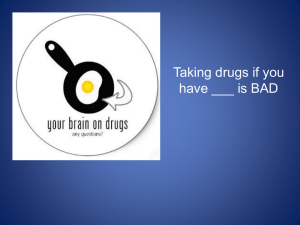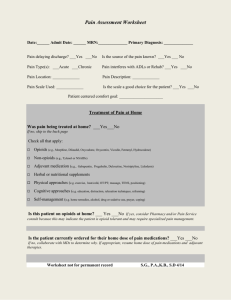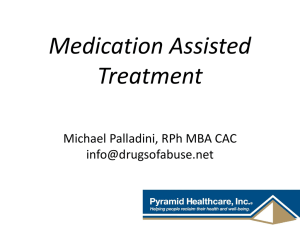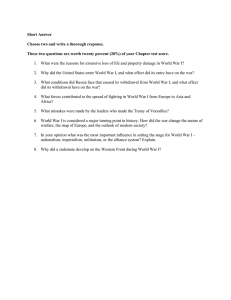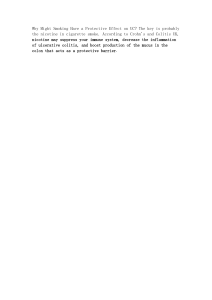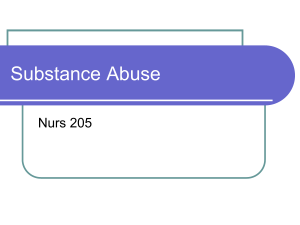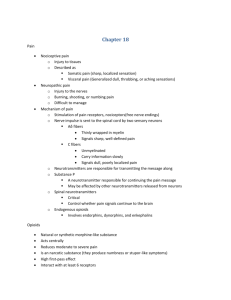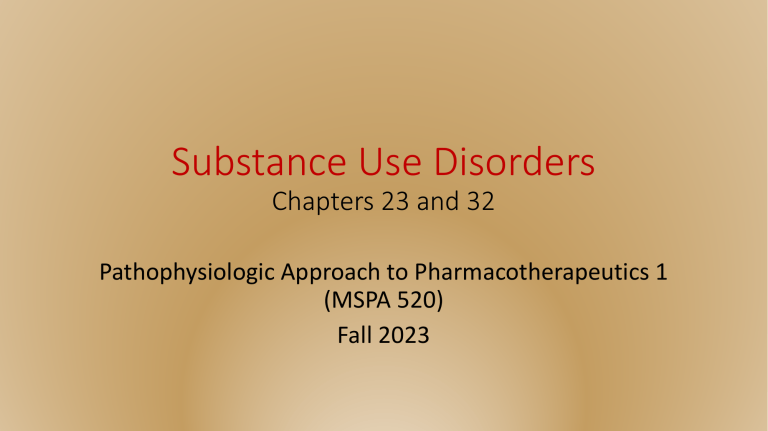
Substance Use Disorders Chapters 23 and 32 Pathophysiologic Approach to Pharmacotherapeutics 1 (MSPA 520) Fall 2023 Learning Objectives 1. Describe the pharmacologic actions of nicotine, opiates, and alcohol 2. Describe the biochemical and physiologic alterations common to substance use disorders. 3. Identify the symptoms of acute intoxication and withdrawal from drugs of abuse 4. Select an appropriate treatment regimen for the treatment of intoxication and withdrawal effects from drugs of abuse 5. Select a pharmacologic treatment for the maintenance treatment of substance dependence 6. Identify legislation that enables the use of prescribed controlled substances for opioid use disorder. Definitions • Physical Dependence – develops when recurrent drug use leads to a state where specific physical withdrawal symptoms occur when an individual stops taking the drug • Psychological Dependence – develops when recurrent drug use is driven by powerful cravings to obtain the pleasurable effects of the drug • Tolerance – state of adaptation in which exposure to a drug induces changes that result in a diminution of one or more of the drug's effects over time Substance Use Disorder (DSM-5) • A cluster of cognitive, behavioral, and physiological symptoms indicating that the individual continues using the substance despite significant substance-related problems • Underlying changes in brain circuits that may persist beyond detoxification, particularly in individuals with severe disorders • Pathological pattern of behaviors related to use of the substance. Addiction • Chronic brain disease • Compulsive use of substance despite serious detrimental consequences • Impaired control over use of the drug • Stages • Experimental use • Recreational use • Early dependency/abuse • Full dependence/compulsive use Reward of Adaptive Behavior • Humans evolved to have systems in place to mediate behaviors involved in survival • Sex • Food • Social interaction • Avoidance of aversive events • Three main regions in the brain • Nucleus accumbens – positive reward • Amygdala – negative/fear-motivated behavior • Prefrontal cortex – assigns stimulus to behavioral response Brain Pathways Reward Pathway • Natural rewarding behaviors and drugs of abuse increase dopamine in the nucleus accumbens • Causes an acute “high” • Drugs of abuse increase dopamine to greater levels than with natural rewards • Short-term reinforcement is linked to rate of increase of dopamine levels • Faster acting drugs are more rewarding and produce more dependence (injected opioids, snorted cocaine) • Reward system becomes completely controlled by drug of abuse over time • Leads to continued drug seeking despite tolerance to positive effects to drugs Dopamine: The Common Neurotransmitter • Direct increases – inhibition of reuptake or stimulation of release at NAc • Cocaine • Amphetamine • Indirect increases – from other transmitters affecting the mesolimbic system • • • • • • Natural rewards Alcohol – via GABA and opioid system Opioids – via mu-opioid receptor Nicotine – nicotinic cholinergic receptor Cannabis – via endocannabinoid and opioid system NMDA antagonists (hallucinogens) Reward Circuitry Nicotine Nicotine Pharmacology • Cholinergic agonist • Rapidly absorbed from mouth or respiratory tract • Effects are dependent on dose • May stimulate or depress CNS • Skeletal muscle relaxation • Peripheral vasoconstriction, ↑ bp, ↑hr • Increased alertness and cognitive function • Pleasure and relaxation • Activates reward system • Adaptation and tolerance with repetitive exposure Neurochemical Related Effects N O â Dopamine â Norepinephrine â Acetylcholine â Glutamate T â Serotonin I C I N E â b-Endorphin â GABA Pleasure, appetite suppression Arousal, appetite suppression Arousal, cognitive enhancement Learning, memory enhancement Mood modulation, appetite suppression â Reduction of anxiety and tension â Reduction of anxiety and tension â â â â â Nicotine reaches the brain within 11 seconds! Nicotine Withdrawal • Can last 2-4 weeks after quitting • Increased skin temperature • Anxiety • Cravings (for cigarettes and food) • Difficulty concentrating • Frustration • Irritability and impatience • Hostility • Insomnia and restlessness • Cravings (psychological dependence) can last months-years Health Risks of Smoking • CV disease • Stroke • MI • Lung disease • Asthma • Chronic bronchitis • Emphysema • Cancer • • • • Lung Head and neck Leukemia Others • Reproductive effects • Reduced fertility • Poor pregnancy outcomes • Infant mortality • Other • • • • Cataract Osteoporosis Periodontitis Poor surgical outcomes Compounds in Tobacco Smoke An estimated 4,800 compounds in tobacco smoke, including 11 proven human carcinogens Gases n n n n n Carbon monoxide Hydrogen cyanide Ammonia Benzene Formaldehyde Particles n n n n n Nicotine Nitrosamines Lead Cadmium Polonium-210 • Nicotine is the addictive component of tobacco products, but it does NOT cause the ill health effects of tobacco use. • These compounds are responsible for CYP450 1A2 induction effects of smoke Nonpharmacologic Strategies Cognitive • Thinking about cigarettes doesn’t mean you have to smoke. • Tell yourself, “It’s just a thought,” or “I am in control.” • Say the word “STOP!” out loud, or visualize a stop sign. • As soon as you get up in the morning, look in the mirror and say to yourself “I am proud that I made it through another day without tobacco.” Behavioral • Control the environment • Tobacco-free home and workplace • Remove cues to tobacco use; actively avoid trigger situations • Substitutes for smoking • Take a walk, diaphragmatic breathing, self-massage • Actively work to reduce stress, obtain social support, and alleviate withdrawal symptoms Pharmacologic Strategies • Nicotine replacement • Reduces physical withdrawal • Eliminates immediate, reinforcing effects of nicotine • Allows for focus on behavioral and psychological aspects • Bupropion – NE/DA reuptake inhibitor • Dopamine = mimics rewarding effects • Norephinephrine = reduces withdrawal symptoms • Varenicline (Chantix) – selective nicotinic agonist • Greater affinity than nicotine – blocks binding • Stimulates release of dopamine to mimic rewarding effects Nicotine Replacement • Gum • Nicorette and generics • Lozenge • Commit • Nicorette and generics • Patch • NicoDerm and generics • Nasal spray • Nicotrol (Rx) • Inhaler • Nicotrol • E-cigarettes NRT General Guidelines • Avoid in recent (≤ 2 weeks) post-MI patients or serious angina pectoris • Avoid in pregnancy (category D) • Not available OTC for adolescents • Therapy typically begins on the patient’s quit day • Preloading strategy may reduce satisfying effects of smoking Nicotine Gum/Lozenge • Available in 2- and 4-mg doses • Gum – chew until peppery/minty taste, then park between cheek and gum • Lozenge – allow to dissolve in mouth for 2030 min • Dose every 1-2 hrs initially, then increase interval to 2-4, then 4-8 hours over several weeks • May self-titrate as needed • Satisfies oral cravings Nicotine Patch • Available in 21-, 14-, and 7-mg/day strengths • For >10 cigs/day: start 21-mg patch for 4-6 wks, then use 14- and 7-mg patches for 2 wks each • For <10 cigs/day: start 14 mg/day for 6 wks, then 7 mg for 2 wks • May wear patch for 16 hrs and remove at bedtime if pt has sleep disturbance • Can supplement with gum/lozenge for acute management of symptoms Nicotine Nasal Spray/Inhaler • NS: 0.5 mg nicotine/spray • 1 spray given in each nostril 1-2 times/hr • Fastest delivery of nicotine • Inhaler: 4 mg nicotine vapor/cartridge • Each cartridge (10 mg) used over 20 minutes • Delivery method simulates smoking • Recommended to be used for 3-6 months • Patients may self-titrate dose E-cigarettes • Utilizes liquid nicotine containing solutions • Devices heat solution producing a vapor that is inhaled, delivering nicotine via the respiratory tract • Solution pods may also contain flavoring and other inert chemicals • Typically only contain trace amounts of carcinogenic chemicals • Risks • Burns • Nicotine dependence in youth – potential ‘gateway’ for cigarette use • Unclear risks of lung disease (E-cigarette or Vaping use-Associated Lung Injury-EVALI) and cancer Bupropion SR (Zyban) • Reduces withdrawal and cravings by inhibiting DA and NE reuptake • Dose: 150 mg PO daily × 3 days, then 150 mg BID • Start 1-2 weeks prior to quit date • Duration: 3-6 months • May be used in conjunction with NRT • AE: Agitation, nausea, insomnia, weight loss, lowering of seizure threshold • Contraindicated in seizure disorders, eating disorders Varenicline (Chantix) • Partial agonist at α4β2 nicotinic receptor • Reduces withdrawal symptoms • Prevents full agonist binding – blocks effects of nicotine from smoking • Titration – started 1 week prior to quit date • 0.5 mg daily for 3 days • Increase to 0.5 mg twice daily for 3 days • Increase to 1 mg twice daily for 12-weeks • May repeat a 12-week course if not fully abstinent Varenicline (Chantix) • Common Adverse Effects • Nausea • Constipation • Insomnia, abnormal dreams • Headache • Warnings • Increased effects of alcohol • Seizures • Psychiatric Adverse Effects • Mood changes – depression or mania • Psychosis – hallucinations, paranoia, delusions, homicidal ideation, • Aggression, hostility, agitation • Anxiety and panic • Suicidal ideation, suicide attempts, or completed suicide Alcohol Use Disorder Alcohol • A CNS depressant affecting gamma amino-butyric acid (GABA), glutamate, and dopamine • Dose-dependent CNS depression • Euphoria, disinhibition • Impaired judgment, reasoning • Ataxia, vision impairment; slurred speech • Sedation, sleep • Unconsciousness • Coma • Respiratory depression and cardiovascular collapse Dosing • Equivalent amounts (14 g alcohol) • 1 12-oz can of beer • 4 oz of wine • 1 shot (1.5 oz) whiskey • Increases BAL 20-25 mg/dL in a healthy 70-kg male • Lethal dose varies, but generally seen with BAL >400-500 mg/dL Alcohol PK – Absorption • 5-10 min: Absorption begins in the stomach. • 30-90 min: Peak blood ethanol levels after oral consumption in fasting subjects. • Food slows absorption. Alcohol PK – Metabolism • Occurs in stomach and liver (>90% in liver). • ADH is main pathway for metabolism. • Gastric metabolism accounts for gender and ethnic differences. • Nonlinear elimination=higher doses saturates enzymes. • Zero-order elimination kinetics • Chronic heavy drinkers metabolize at 2x normal rate – associated with behavioral tolerance Wernicke’s Encephalopathy • Associated with thiamine deficiency from prolonged alcohol consumption • Medical emergency – 10-20% mortality • CNS depression: mental sluggishness, restlessness, confusion, coma • Ambulatory difficulties: wide-based ataxic gait • Ocular problems: horizontal nystagmus, pupillary abnormalities, retinol hemorrhages, papilledema • Other: hypothermia, hypotension, polyneuropathy Korsakoff’s Psychosis • Often a progression from Wernicke’s Encephalopathy • 80% who survive but do not recover in 48 to 72 hr will progress. • Symptoms: psychosis, retrograde amnesia (inability to recall info), anterograde amnesia (inability to assimilate new info), confabulation. • Slow and incomplete recovery in most • 25-50% do not recover and require long-term care Alcohol Withdrawal • Stage 1 (6-8 hr): tremulousness, anxiety, hyperreflexia, hypertension, tachycardia, diaphoresis, hyperthermia, nausea, vomiting, insomnia, and craving due to moderate autonomic hyperactivity • Stage 2 (24 hr): auditory and visual hallucinations, anxiety, tremor, continued autonomic hyperactivity • Stage 3 (7-48 hr): generalized seizures • Stage 4 (3-5 d): Delirium Tremens (DTs) Delirium Tremens • Symptoms: confusion, hallucinations, agitation, tachycardia, mydriasis, fever. • 5-15% mortality in those left untreated. • Mortality from aspiration, shock, trauma, hyperthermia, arrhythmias, and infection • Risks • Prior history of DTs. • Early signs of withdrawal. • Significant drinking history-equivalent of 1 pint of whiskey/d for 10-14 days • Alcohol induced hepatic dysfunction. Goals of Treatment • Nutritional support • Fluids and vitamins • Symptomatic management of withdrawal • Prevention of seizures and DTs • Long-term abstinence after detoxification Treatment of Nutritional Deficits • Thiamine – for prevention of Wernicke-Korsakoff syndrome • Must be given prior to glucose-containing solutions in suspected cases of WE • Initial: 500 mg IV or IM • Continue to give 100-250 mg daily for 3-5 days • Hydration – to correct dehydration • Electrolytes • Oral potassium • Magnesium and phosphorous may correct gradually with adequate diet • Multivitamin supplementation Management of Alcohol Withdrawal • Drug of choice – benzodiazepines • Cross-tolerant with alcohol • Prevents seizures and DTs • Dosing regimens – Scheduled vs. Symptom-triggered dosing • Alternatives • Divalproex • Carbamazepine • Gabapentin Benzodiazepines used in AUD • Chlordiazepoxide (Librium) – PO • Diazepam (Valium) – PO, IV • Lorazepam (Ativan) – PO, IM, IV • Oxazepam (Serax) – PO Benzodiazepine Pharmacology • A large group of CNS depressant drugs with similar chemical structure and pharmacologic effects • Facilitate activity of GABA – main CNSdepressant neurotransmitter • Acts as a positive allosteric modulator at the chloride channel • Increases affinity of GABA at binding site • Chloride entry leads to hyperpolarization • Produces hypnosis, anxiolytic, anticonvulsant, and muscle relaxant effects • Cross-tolerant with alcohol Benzodiazepine PK • Onset – determined by absorption and entry into CNS • Very fast with parenteral agents: lorazepam, diazepam • Fast with oral lipophilic agents: diazepam, chlordiazepoxide • Slower with oral hydrophilic agents: lorazepam • Duration of action – determined by elimination half-life, presence of active metabolites, and redistribution from CNS • Long: chlordiazepoxide, diazepam • Shorter: lorazepam, oxazepam Benzodiazepines: Symptom-Triggered Therapy • Current standard of care in alcohol detox • Medication given only when patient has symptoms • Generally leads to shorter treatment course and less oversedation • Use objective measure (e.g. CIWA scale) to assess symptom and determine dosing • Sample regimen: chlordiazepoxide 25-100 mg q1hr PRN CIWA-Ar score>8 Benzodiazepines: Scheduled Dosing • Examples of standing protocols: • Chlordiazepoxide 50 mg q2-4h • Diazepam 10 mg q2-4h • Oxazepam 60 mg q2h • Lorazepam 1 mg q2h • PRN dosing x 24 hrs to suppress autonomic hyperactivity and CNS irritability • Total dose is then given the next day in 4 divided doses • Taper over 3-5 days. • Maximum dose: equivalent of 600 mg/d of chlordiazepoxide. Anticonvulsants for Withdrawal • May be useful for less severe cases of withdrawal in ambulatory patients • Not effective for reducing risk of DT’s and seizures • Gabapentin • Comparable efficacy to benzos with less sedation • Start at 900-1200 mg, then taper over 4 days • Carbamazepine • Comparable efficacy to gabapentin and benzos, but more nausea and CNS depression • Start at 600-800 mg, then taper over 4 days Maintenance Therapy • Intended for chronic treatment of AUD for relapse prevention • Treatment works best after withdrawal symptoms have subsided • FDA Approved • Disulfiram (Antabuse) • Naltrexone PO (ReVia) and LAI (Vivitrol) • Acamprosate (Campral) • Alternatives (Currently off-label) • Topiramate • Gabapentin Disulfiram (Antabuse) • Irreversible acetaldehyde dehydrogenase inhibitor • Can take up to 14 days for new enzymes to be produced • Produces a severe aversive reaction after alcohol intake • flushing, nausea, vomiting, tachycardia • Potentially cardiovascular collapse and death. X Disulfiram • Efficacy is highest in highly motivated patients or those legally mandated to take it • Adherence is a strong predictor of positive outcome. • May reduce drinking, but does not significantly achieve total abstinence, delay relapse, or improve employment status • Adverse effects: dermatitis, garlic-like or metallic after-taste, hepatitis, optic neuritis, peripheral neuropathy, psychotic reactions, nausea, headache. • Drug Interactions: • Inhibits CYPP450 3A4 • Topical and OTC products containing alcohol Naltrexone • Mechanism: opioid antagonist – reduces reinforcing effect of alcohol consumption • Efficacy • Small to moderate benefit depending on study outcomes • Benefit for binge drinkers • Significant effect on the maintenance of abstinence and prevention of heavy drinking • Dosing – can be initiated while patient is still drinking • Oral (ReVia): 50 mg daily • IM (Vivitrol inj): 380mg once every 4 weeks deep into gluteal muscle. Naltrexone • Precaution: acute hepatitis, liver failure, cirrhosis. Hepatoxicity is dose-related. • Adverse Effects: GI pain/nausea, constipation, anxiety, headache, hepatotoxicity, opioid-withdrawal syndrome. • Patient education • Limit nausea by starting after sufficient abstinence, with low dose, titrate slowly • Patient should be opioid-free for 7-14 days before starting • Pain management: opioid doses given to overcome naltrexone may result in fatal OD. Non-opioid such as NSAID should be used, if possible. Acamprosate (Campral) • Glutamate modulator at NMDA receptor – reduces alcohol craving • Supports overall abstinence; no effect on consumption after first drink • May have improved outcome in combination with naltrexone • Dosing: 666 mg (2 333mg tablets) tid. • No titration on initiation. • Poor bioavailability. Takes several days to achieve therapeutic blood levels. • Therapy should be continued regardless of relapse. • Decrease dose to 333mg tid for CrCl 30-50ml/min. Do not use with CrCl<30ml/min. Acamprosate • Adverse Effects: diarrhea most commonly reported • Drug Interactions: • Does not interact with alcohol. • Coadministration with naltrexone resulted in 33% inc Cmax and 25% inc AUC of acamprosate. No dosage adjustment necessary. • Acamprosate may decrease effects of tetracyclines. Topiramate (Topamax) • Believed to antagonize glutamate receptors, inhibiting dopamine release in the reward center • Outcomes • Reduced drinks per drinking day • Reduced % of drinking days and heavy drinking days • Dosing • Initial: 50 mg PO daily • May need 100 mg PO BID • Maximum: 300 mg daily – titrate over several weeks • Dose adjustments in renal (CrCl<70) and hepatic impairment Topiramate • Adverse Effects • Cognitive dulling • Sedation • Paresthesia • Abdominal pain, anorexia • Should be gradually tapered when stopping therapy • May decrease efficacy of oral contraceptives Gabapentin (Neurontin) • Likely mechanism is through modulation of GABA activity in the amygdala • Outcomes • • • • Increased rates of abstinence Decreased heavy drinking Possible useful in co-occurring neuropathic pain Possible adjunct to naltrexone • Dosing • • • • Initiate at 300 mg PO daily Increase by 300 mg daily, as tolerated Target dose: 1800 mg PO daily in three divided doses Limit dose in renal impairment (CrCl < 60) Gabapentin • Adverse Effects • Dizziness • Drowsiness • Somnolence • Ataxia • May cause additive CNS depression with alcohol, opioids, and benzos Opioid Use Disorder Definitions • Opiates: All naturally occurring alkaloids derived from opium (the sap from the immature Papaver Somniferum) and semisynthetic • Opioids: All drugs (natural & synthetic) with morphine like activity. • Narcotics: Legal term for this group of drugs. Drugs • Agonists • Natural: Morphine, Codeine • Semisynthetic: Heroin, Hydromorphone, Hydrocodone, Oxymorphone, Oxycodone, Dextromethorphan • Synthetic: Methadone, Meperidine, Fentanyl, Propoxyphene, Tramadol; Diphenoxylate • Partial agonist: Buprenorphine • Agonist-antagonist: Pentazocine, Butorphanol,Nalbuphine • Antagonists: Naloxone, Naltrexone, Nalmefene Opioid Mechanism of Action (MOA) • *Mu (μ) receptor: analgesia, euphoria, respiratory depression, pupillary constriction, constipation • Kappa (κ) receptor: analgesia, dysphoria, diuresis • Delta (δ) receptor: analgesia Clinical Effects • Analgesia • Euphoria • CNS Depression • Drowsiness, lethargy, stupor, or coma • Respiratory Depression • Apnea, hypoxia, non-cardiogenic pulmonary edema (NCPE) • Pin-point pupils • May be normal or dilated if hypoxic or if coingestants are involved (scopolamine and cocaine) Other Clinical Effects • Cardiac: hypotension, bradycardia • GI: *constipation, nausea, vomiting • GU: Urinary retention • Histamine release à pruritis and flushing • Hypothermia Medical Complications - IVDA • HIV/AIDS • Endocarditis • Pneumonia • Hepatitis • Embolism • Abscess Heroin • Horse, smack, antifreeze, China White, dust, H, Harry, junk, Mexican brown • Use is rising - price has ¯ by 2/3; purity has ­ from <10% to 96% • Snorted, smoked, injected • Adulterants always present • Fentanyl • Caffeine • Quinine • Talc Codeine Equivalents Codeine Equivalents Codeine Meperidine Pentazocine Morphine Oxycodone Dihydrocodeine Hydromorphone Oxymorphone Mg 100 150 100 30 15 10 3.75 3 Conversion factor 1 0.7 1 3.3 6.7 10 26.7 33.3 Goals of Opioid Dependence Treatment 1. Crisis intervention for resuscitation in event of overdose 2. Stable abstinence • Evaluation of motivation for recovery • Detoxification • Relapse prevention 3. Reduction or discontinuation of illicit opioids and improvement of health and social function • Maintenance treatment • Harm avoidance • Rehabilitation Managing Opioid Overdose • Call for emergency assistance • Support respiration • Ventilate with 100% oxygen before naloxone is administered to reduce the risk of acute lung injury • When 100% oxygen is not available, rescue breathing very effective in supporting respiration • Administer naloxone Naloxone • Opioid antagonist available OTC via standing order • Can be administered intranasal, IM, IV, SC • Usually intranasal or IM outside of hospital • Only produces effect when administered to someone who has used opioids so relatively safe • Few side effects but can precipitate withdrawal • Response within 3-5 minutes; duration of action 30-90 minutes • Dosing • Intranasal: 2mg/2ml. Administer 1ml per nostril. Can readminster in 35 minutes, if necessary • IM: 0.4mg/ml. Inject 1ml IM. Can readminster in 3-5 minutes, if necessary • Monitor for >4 hours for reemerging symptoms Rescue Breathing • Verify that the airway is clear • Tilt the head back and pinch the nose closed • Place your mouth over the patient's mouth to make a seal and give 2 slow breaths • Continue with one breath every 5 seconds. Opioid Withdrawal • Signs and Symptoms • Agitation, anxiety, myalgia, rhinorrhea, insomnia, diarrhea, mydriasis, nausea, vomiting • Time Course • Onset: 8-14 hr • Peak: 36-72 hr • Duration: 5-10 days Opiate Dependence Treatment • Acute Withdrawal – symptomatic management of discomfort • Inpatient setting • Detoxification – to end drug use and reduce relapse • Inpatient or outpatient • Maintenance – suppress withdrawal, reduce cravings, and promote psychosocial integration • Outpatient Methadone • Synthetic CNS μ-opioid receptor agonist • Pharmacokinetics • Absorption: 85-100% oral bioavailability • Distribution: • ~80% protein bound • Distribution to lung, liver, spleen, kidney, brain • Metabolism: CYP 3A4, 2B6, 2C19 > 2C9, 2D6 • Elimination: • Parent – t½ = 23 hr • Metabolite – t½ = 42 hr Methadone • Black Box Warnings • Respiratory depression • QTc prolongation by inhibition of cardiac potassium channels • Tablets are for oral administration only • Adverse Effects • • • • • Constipation Sweating Sexual Dysfunction Sedation Respiratory depression • Contraindications • Respiratory depression (without ventilatory support) • Acute bronchial asthma • Paralytic ileus • Hypersensitivity Methadone • Drug Interactions • Additive increase in sedation: benzodiazepines, alcohol, other opioid agonists and CNS depressants • CYP450 inhibitors or inducers (3A4, 2B6, 2C19) • Concomitant QTc prolonging agents • Selegiline • Monitoring Parameters • Mental status and respiratory status • Baseline electrocardiogram (ECG) within 30 days of initiation, annually thereafter • Additional ECG monitoring if methadone dose >100 mg or if seizures or syncopal events occur • Potassium (hypokalemia) Methadone: Practical Considerations • Schedule II Controlled Substance • Narcotic Addict Treatment Act of 1974 first established parameters for methadone treatment in OUD • Must be dispensed from opioid treatment program, approved by Substance Abuse and Mental Health Services and state authority • Treatment can be continued in hospitalized patients after verification from methadone program • Diversion Risk: liquid < tablet • Pregnancy • May allow for priority treatment in MMT programs • Monitor for abstinence in newborn Buprenorphine • Partial μ-receptor agonist with greater affinity than opioids • Pharmacokinetics • Absorption: 30-35% sublingual (SL) bioavailability • Distribution • 96% protein bound • Distribution to blood, cerebrospinal fluid • Metabolism: CYP3A4 and hepatic glucuronidation • Elimination: t½ = 24-42 hr Buprenorphine • Dosage forms • SL tablet (Subutex) – for induction therapy • SL film as combination product with naloxone (Suboxone, Zubsolv) • Naloxone in formulation is for abuse deterrence, very low PO and SL absorption • Implant (Probuphine) – for long term use in stable patients • Adverse Effects • Relatively well tolerated, possible respiratory depression with large doses • Constipation • Drowsiness • Headache • Nausea • Reduced libido Buprenorphine • Contraindications: hypersensitivity • Drug Interactions • CYP 3A4 inhibitors or inducers • Additive increase in sedation: benzodiazepines, alcohol, other opioid agonists and CNS depressants • Monitoring Parameters • Mental status and respiratory status Management of Withdrawal • Methadone • 40-60 mg daily • Taper over 3-7 days • Buprenorphine/naloxone • 4-8 mg initially, tapering over 5 days • Clonidine (not cross tolerant with opioids) • Dose: 0.1 mg PO TID • Duration: 4-6 days for short acting opioids, longer as needed for long acting opioids Opioid Detoxification • Buprenorphine/naloxone • Stabilization Dose: Buprenorphine 8-32 mg/day • Taper: Every 10-14 days • Methadone • Up to 80 mg/day initially • Slow taper Maintenance Therapy • Engage patient in full array of substance abuse rehab treatment • Methadone – within certified treatment program • Use liquid formulation • Dose: 60-100 mg daily • Potentially long-term or life long treatment • Buprenorphine/naloxone – office-based • Sublingual tablets or film • 4/1 to 32/8 mg daily • Potentially long-term or life long treatment DATA Waiver • SAMHSA is federal government body that regulates treatment for opioid use disorder • DATA 2000 (Drug Addiction Treatment Act) was original legislation that allowed of office-based management of opioid addiction • Certified physicians originally limited to 30 patients/practice • Later increased to 100, then 275 patients per physician with SAMHSA approval • Prescribers used an ‘X’ DEA number (e.g. XB1234567) CARA Act • Comprehensive Addiction and Recovery Act was signed into law by Pres. Obama in July 2016 • Expanded privilege of office-based prescribing buprenorphine maintenance to qualifying PAs and NPs • Can treat up to 30 patients with a standard waiver • May increase to 100 after one year and with additional training Waiver Elimination Act (2023) • Law that removed federal requirement for practitioners to have a waiver for prescribing buprenorphine • All DEA-registered prescribers may prescribe buprenorphine as permitted by state law • No patient limits or counseling certifications requirements • Opioid disorder training required for DEA registration Questions? 85
